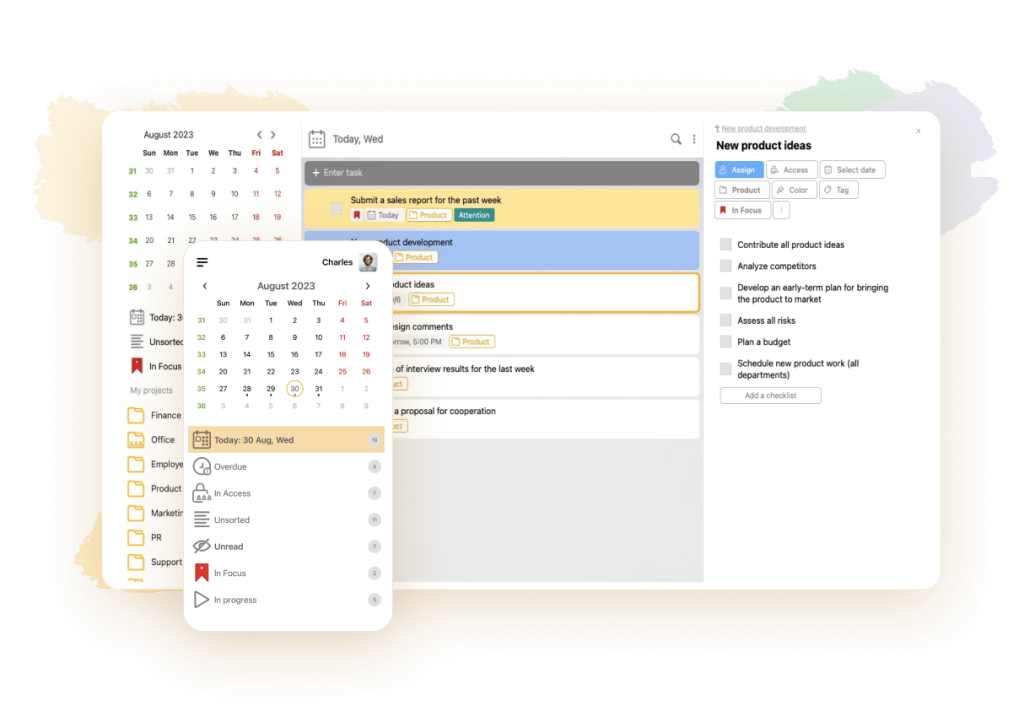Chronophages or time-eaters

The modern pace of life demands maximum concentration and mobility from a person. Otherwise, without learning how to manage time properly, it is impossible to become a successful manager or make a career as a top manager in a large company. But how to use this valuable resource correctly? How to distribute things in such a way that you have time to do everything and have at least a few hours a day to rest? It turns out that it is not difficult at all, if you understand where this time is spent. And then on the surface will “surface” unimportant activities that distract from the main goals and do not give to bring serious business to the end. These are “time eaters” or chronophages.
What it is and how it affects success
In terminology, chronophages are time absorbers, that is, all possible factors that interfere with work or disrupt plans. This term consists of two Greek words: “chronos”, literal translation “time”, and “phage” – “to absorb”. This unusual word was first used by Henri de Monterlan, a classic of French literature. Some sources attribute the authorship of this private definition to another classicist, Andre Morois.
In their interpretation, “chronophage” referred to a person leading an idle lifestyle, who, trying to diversify his leisure time, mercilessly takes time from others. Today, this concept is more widespread. It combines any events, objects, people, activities that contribute to the inappropriate use of time, distracting from the main work tasks. In fact, this term hides all the problems of time management: from force majeure to flaws and mistakes made in planning.
Types of chronophages
Every working person is directly confronted with chronophages. Some “time eaters” are not controlled by a person, arise due to the coincidence of different circumstances. And, others arise in our lives consciously. They can be categorized by:
- Animate and inanimate;
- Controlled and uncontrolled;
- Predictable and spontaneous;
- Personal and public;
- Implicit.
Each of these categories is worth talking about and examining in more detail.
Animate and inanimate.
From the name, it is clear that animate “time absorbers” depend on and are connected to other people and their actions. This group includes all kinds of “empty” communication:
- Talking essentially “about nothing” with coworkers;
- Long discussions of trivial topics with relatives;
- Ineffective communication with customers;
- Not properly preparing meetings, presentations and appointments;
- Frequent talking on the phone for no particular reason.
Quite often they can be associated with the inability to build communication properly. Without learning to refuse, to overcome shyness, it is impossible to protect your precious time from them. Therefore, communication with distracting people should be minimized. This measure will have a positive impact on work and personal productivity.
The inanimate ones include things that are not of practical use, you can usually find such time traps in your comfort zone. If we give examples of inanimate chronophages, they are computer games, television programs, reality shows, series, social networks, blogs and YouTube videos, as well as hobbies. The latter activity has a high chance of becoming a “time eater” if you start devoting the main time to it, which can be spent more usefully.
Controlled and uncontrolled
To the controllability of chronophages refers to the controllable events that a person can control. After all, each of us can independently determine how much time should be allocated to studying various information, reading a book or going to work. These factors, as well as surfing the Internet, socializing with friends, become “time eaters” when these processes get out of control.
Uncontrollable chronophages are risks and situations that a person has no power to prevent. Typical examples:
- Traffic jam on the way to work;
- Client delay;
- Tardiness of the employee or manager with whom the appointment is scheduled.
It is impossible to predict their appearance. But, if you wish, you can transform them into useful and necessary activities. If you often have to spend time in traffic jams – devote these precious hours and minutes to learning foreign languages or self-development trainings. To do this, you only need to purchase the material of interest in audio format. While waiting for a business colleague, you can solve personal issues. Or check e-mail, make notes for the meeting. And the time freed from these matters can be spent more usefully.
Predictable and spontaneous occurrences
These “time eaters” are similar in content to controlled and uncontrolled chronophages. Are you late for morning meetings because you get to work during rush hour, are you aware of your business partner’s unpunctuality, and does it throw you off your work rut? Knowing the inevitability of these events, you can tweak them. For example, leave earlier.
Spontaneous “time eaters” are various external circumstances. For example, a sudden car breakdown on the road, computer equipment failure before a video conference with a client or other force majeure factors. To level their consequences, a good manager or supervisor should always have a backup plan that tells them what to do when certain problems arise.
Another effective way to get rid of such wasted time is to prioritize tasks. All important tasks should be planned for the beginning of the week, day or month. The earlier you start their realization, the less risk you have of being caught in a force majeure.
Personal and public
Personal chronophages are internal motives of each person. They are related to his temperament, character, personality traits. They include:
- Fatigue;
- Laziness;
- Procrastination;
- Bad mood;
- Lack of motivation;
- Loss of interest in life;
- Lack of desire to work;
- Dislike for the business you do, your colleagues, the team;
- Disappointing work;
- Stress or depression.
Laziness, procrastination and lack of motivation are a danger to anyone’s time, and other minor chronophages can come from these factors. To eliminate this range of factors, you need to learn to understand yourself, your feelings and desires. Knowing what causes certain negative circumstances, it is much easier to eliminate or remove them from your life. Attention to oneself, regular self-analysis, timely, quality rest, development of self-discipline and self-motivation will help.
Social chronophagists are connected to their surroundings and external circumstances. They can be managed by keeping to a schedule, good planning, self control and the ability to always “keep your finger on the pulse of events”.
What are implicit chronophages
This group includes various organizational points, such as:
- Inability to categorize cases by importance and priority;
- Incorrectly formulated vague and simplistic objectives;
- Lack of structure in the tasks;
- Failure to plan or complete disregard for the process;
- Lack of information;
- Disorganized, fidgety, habit of dissipating on secondary matters;
- Lack of motivation;
- Overexertion, poor health.
In fact, all of the above factors are related to the person. Therefore, they can and should be identified and eliminated in a timely manner.
Methods for identifying “time eaters”

To successfully control chronophages, you need to learn how to find and classify them. To do this, you can use one of the following methods:
- Analysis by type
To do this, make a table in which you write down the main problems you face most often. The table can be divided into the following types:
| Chronophages | Problems |
| Inanimate | Browsing social media; YouTube clips; Checking email; Searching for information on the internet, etc. |
| External, animate | Unproductive communication with a partner; Ineffective meetings; Receiving guests at inconvenient times; Lengthy phone conversations that are not substantive. |
| Uncontrollable, Force Majeure | Traffic jams; Computer, office equipment failure; Flight delay. |
| Personal | Internal dissatisfaction with work, position; Stress due to overload; Excessive perfectionism; Fatigue at the end of the day. |
| Implicit, organizational, public | Inability to delegate assignments; Incompetent plan. |
- Retrospective
The method consists in regularly analyzing the events that occurred during the current day. We remember all the actions that were performed during the day. We analyze which of them wasted time. You can use to-do lists or daily schedules for orientation.
- Timekeeping method
With this simple method you can identify all “time eaters” and neutralize them. It is quite labor-intensive, but effective. To do this, you need to write down all your activities for a week, indicating their duration by time. Example:
| Type of activity (W-work, C-chronophage, R-rest) | Class | Beginning of execution | Duration |
| W | Report writing | 9.10 | 40 min |
| C | Reading news | 9.50 | 10 min |
| W | Project meeting | 10.00 | 45 min |
| R | Coffee break | 10.45 | 15 min |
As a result of the table, it is possible to fully predict activities, subdivide time intervals by characteristics, and most importantly designate dangerous chronophages. The frequency of their occurrence and the time they “eat” during the day are specified.
Popular techniques for dealing with chronophages
In time management, there are several techniques to combat the “time eaters” that prevent you from getting important things done. The first is timekeeping, which we considered earlier. It can be done with the help of special programs or mobile applications. If you take the process seriously, scrupulously record each activity, then after a week you can identify the most vicious “time eaters” who destroy most of it during the day.
Another most valid technique: analyzing contested cases. It works as follows:
- Divide the sheet of paper into 4 columns.
- All questionable cases go into the first one.
- The second indicates the time taken to complete them.
- In the third write down the positive aspects of doing them (self-expression, creativity, relaxation, etc.).
- The fourth column is filled in after analyzing the importance of these cases. On this basis, a certain amount of time is allocated to them, making sure that they do not compromise the main work.
Other ways to get rid of “time absorbers”:
- Planning and proper prioritization. These tools will help you rationally distribute the available resources and focus on priority tasks. It is not necessary to keep everything in your head – be sure to write down all the things you need to do and tasks. Do not add more than 2-3 important tasks to your daily list. Once you have made a plan, follow it clearly. Learning to plan, you will become more mobile and maneuverable. You will always know which items in it really work, and which ones need to be adjusted according to changed conditions.
- Organized and goal-oriented. These qualities are important both for a leader and for a manager who seeks to climb the career ladder. Concentrating on the main activity, properly organizing working time and place, you can easily get rid of chronophages.
- Extracting personal benefit from “time pits” arising from external causes. Expecting a partner who is late for a meeting? Call a family member or reply to a messenger message. You’re sure to have things to do and tasks to fill the empty space.
Time management tips
Separate time for work and rest. It is best to plan in a 60/40 ratio. Most of it should be allocated to the main work tasks. The remaining 40% should be allocated to chronophages: coffee breaks, conversations with colleagues, and various unplanned activities.
To work properly, it is important to organize your workspace. The brain works best when time is limited, when everyone around you is busy working and there are no external distractions.
Remember self-discipline. Soberly assess your strength and capabilities. Do not plan for the whole day a huge number of uncontrollable things that you can not under any circumstances to finish. And do not do several things at the same time.
Modern time management tools – LeaderTask

Possession of planning skills gives a lot of advantages in project management, organization of management work in a team and personal activities. Modern tools have been developed for time management, one of which is the digital app LeaderTask.
The service supports the use of all classic time management techniques, including GTD, Pomodoro, AutoFocus and many other methods. Combines the capabilities of a planner, daily planner-organizer, CRM system to organize successful work with colleagues and clients. Works in online and offline mode, without Internet connection. Helps minimize non-targeted activities and chronophages due to a special tool “Timekeeping”.
In the program you can create to-do lists, tasks, manage projects, assign tasks and select an executor for them, control the execution of tasks. Create reports, track employee performance and personal efficiency.
Conclusion
In today’s world, chronophages are useless, low value processes and activities that ruthlessly steal modern man’s most valuable resource – time. It is necessary and possible to fight them. To remove these “time eaters” from your life, rational planning, clear structuring of tasks and self-discipline will help.



